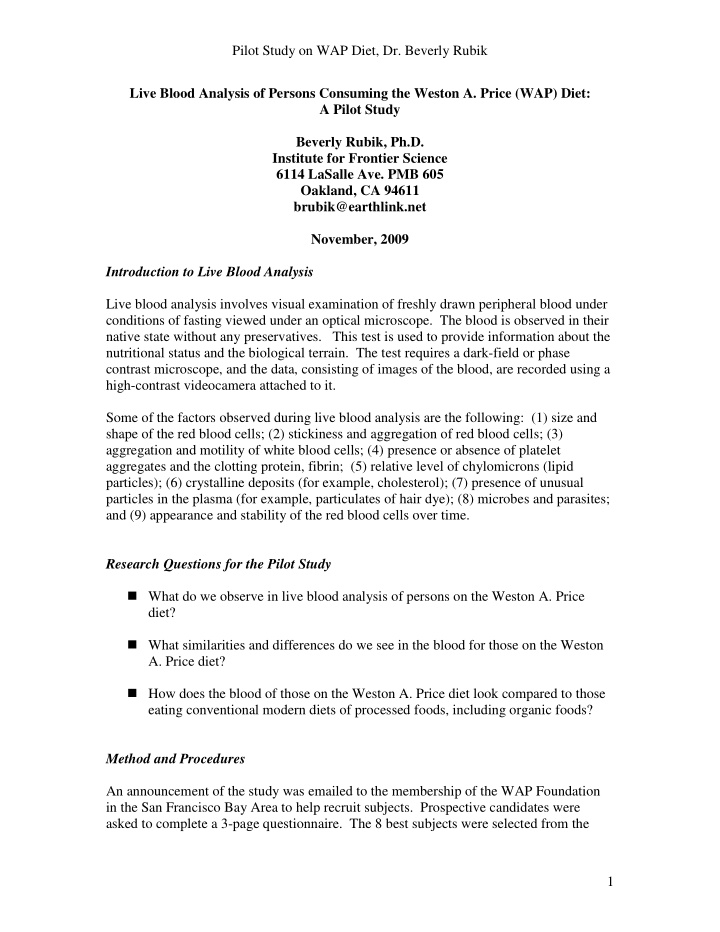



Pilot Study on WAP Diet, Dr. Beverly Rubik Live Blood Analysis of Persons Consuming the Weston A. Price (WAP) Diet: A Pilot Study Beverly Rubik, Ph.D. Institute for Frontier Science 6114 LaSalle Ave. PMB 605 Oakland, CA 94611 brubik@earthlink.net November, 2009 Introduction to Live Blood Analysis Live blood analysis involves visual examination of freshly drawn peripheral blood under conditions of fasting viewed under an optical microscope. The blood is observed in their native state without any preservatives. This test is used to provide information about the nutritional status and the biological terrain. The test requires a dark-field or phase contrast microscope, and the data, consisting of images of the blood, are recorded using a high-contrast videocamera attached to it. Some of the factors observed during live blood analysis are the following: (1) size and shape of the red blood cells; (2) stickiness and aggregation of red blood cells; (3) aggregation and motility of white blood cells; (4) presence or absence of platelet aggregates and the clotting protein, fibrin; (5) relative level of chylomicrons (lipid particles); (6) crystalline deposits (for example, cholesterol); (7) presence of unusual particles in the plasma (for example, particulates of hair dye); (8) microbes and parasites; and (9) appearance and stability of the red blood cells over time. Research Questions for the Pilot Study What do we observe in live blood analysis of persons on the Weston A. Price diet? What similarities and differences do we see in the blood for those on the Weston A. Price diet? How does the blood of those on the Weston A. Price diet look compared to those eating conventional modern diets of processed foods, including organic foods? Method and Procedures An announcement of the study was emailed to the membership of the WAP Foundation in the San Francisco Bay Area to help recruit subjects. Prospective candidates were asked to complete a 3-page questionnaire. The 8 best subjects were selected from the 1
Pilot Study on WAP Diet, Dr. Beverly Rubik respondents to participate, based on the following criteria. Participates must be over 25 years old; have no serious illnesses or health conditions; take no prescription drugs; consume the WAP diet for at least the past 2 years; and conform to the principles of the WAP diet at least 80% of the time. Live blood analysis was done only once with each subject, who fasted at least 5 hours before testing. The blood factors were scored using a Likert scale questionnaire developed for live blood analysis. Photographs and short videos of the blood as seen under the microscope were made. Preliminary Results Data from this study are being compared to that for persons, matched for age, eating conventional modern diets, including organic foods. Preliminary analysis shows a constellation of factors that seem to be unique to those on the WAP diet compared to conventional modern diets: (1) Relatively less blood coagulation was observed initially, including less aggregation or clumping of red blood cells, less platelet aggregates (small cells that clump together to initiate blood clotting), and less fibrin (clotting protein). (2) After one hour, very little or no fibrin and hardly any blood clotting was observed. (3) The level of chylomicrons (lipid particles) observed in the blood was relatively high. Further analysis of data is still underway. Preliminary Conclusions and Discussion Preliminary results suggest that for those on the WAP diet, blood congestion is considerably less than for those on conventional modern diets. Blood coagulation (clotting) is not apparent initially and is also inhibited for up to one hour. This is important, because early blood clotting is linked to inflammatory processes in the body. That is, when biochemical inflammatory pathways are turned on in the body, the blood clots faster, because inflammatory factors cause platelets to aggregate, blood cells to stick together and clump, and fibrin to form. On the other hand, when inflammatory pathways are not activated, then these processes do not take place, and blood clotting is inhibited. Chronic biochemical inflammation is believed to be an underlying cause of virtually all the chronic degenerative diseases, including cardiovascular disease, cancer, and arthritis. Therefore, preventing chronic inflammation in the body is believed to be central to preventing chronic disease. 2
Pilot Study on WAP Diet, Dr. Beverly Rubik The relative absence of inflammation seen in the blood of persons consuming the WAP diet is not surprising. It is consistent with the WAP philosophy of eating natural whole foods that are fresh, wholesome, and unprocessed, except for the use of fermentation to make nutrients more accessible while breaking down toxic constituents in foods such as grains. Healthy foods “tell” our bodily tissues not to initiate inflammation, because there is nothing to fight. Such whole foods have less toxic constituents in them compared to conventional processed foods such as cereal flakes produced by heat, and the pasteurization of milk, which lead to denatured proteins that may be antigenic and cause the body to initiate the biochemistry of inflammation to fight them. Moreover, the high probiotic content in the fermented foods of the WAP diet would be expected to facilitate a healthy colon, thus preventing problems such as leaky gut syndrome, whereby undigested proteins leak into the blood stream activating the inflammatory cascade. Therefore, it would be expected that for persons consuming the WAP diet, there would be less activation of allergic reactions and other inflammatory processes in the body. 3
Recommend
More recommend